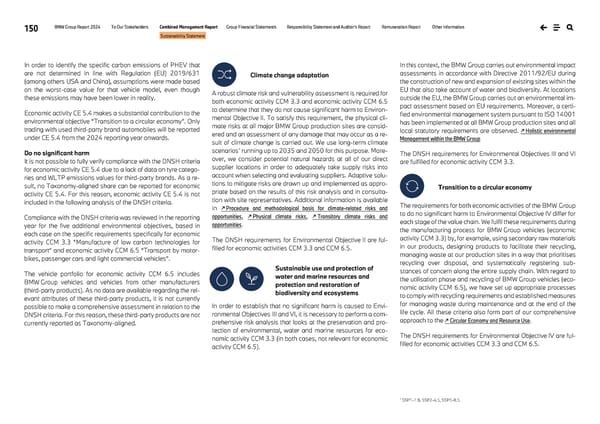150 BMW Group Report 2024 To Our Stakeholders Combined Management Report Group Financial Statements Responsibility Statement and Auditor’s Report Remuneration Report Other Information Sustainability Statement In order to identify the specific carbon emissions of PHEV that are not determined in line with Regulation (EU) 2019/631 (among others USA and China), assumptions were made based on the worst-case value for that vehicle model, even though these emissions may have been lower in reality. Economic activity CE 5.4 makes a substantial contribution to the environmental objective “Transition to a circular economy”. Only trading with used third-party brand automobiles will be reported under CE 5.4 from the 2024 reporting year onwards. Do no significant harm It is not possible to fully verify compliance with the DNSH criteria for economic activity CE 5.4 due to a lack of data on tyre catego- ries and WLTP emissions values for third-party brands. As a re- sult, no Taxonomy-aligned share can be reported for economic activity CE 5.4. For this reason, economic activity CE 5.4 is not included in the following analysis of the DNSH criteria. Compliance with the DNSH criteria was reviewed in the reporting year for the five additional environmental objectives, based in each case on the specific requirements specifically for economic activity CCM 3.3 “Manufacture of low carbon technologies for transport” and economic activity CCM 6.5 “Transport by motor- bikes, passenger cars and light commercial vehicles”. The vehicle portfolio for economic activity CCM 6.5 includes BMW Group vehicles and vehicles from other manufacturers (third-party products). As no data are available regarding the rel- evant attributes of these third-party products, it is not currently possible to make a comprehensive assessment in relation to the DNSH criteria. For this reason, these third-party products are not currently reported as Taxonomy-aligned. Climate change adaptation A robust climate risk and vulnerability assessment is required for both economic activity CCM 3.3 and economic activity CCM 6.5 to determine that they do not cause significant harm to Environ- mental Objective II. To satisfy this requirement, the physical cli- mate risks at all major BMW Group production sites are consid- ered and an assessment of any damage that may occur as a re- sult of climate change is carried out. We use long-term climate scenarios* running up to 2035 and 2050 for this purpose. More- over, we consider potential natural hazards at all of our direct supplier locations in order to adequately take supply risks into account when selecting and evaluating suppliers. Adaptive solu- tions to mitigate risks are drawn up and implemented as appro- priate based on the results of this risk analysis and in consulta- tion with site representatives. Additional information is available in ↗ Procedure and methodological basis for climate-related risks and opportunities, ↗ Physical climate risks, ↗ Transitory climate risks and opportunities. The DNSH requirements for Environmental Objective II are ful- filled for economic activities CCM 3.3 and CCM 6.5. Sustainable use and protection of water and marine resources and protection and restoration of biodiversity and ecosystems In order to establish that no significant harm is caused to Envi- ronmental Objectives III and VI, it is necessary to perform a com- prehensive risk analysis that looks at the preservation and pro- tection of environmental, water and marine resources for eco- nomic activity CCM 3.3 (in both cases, not relevant for economic activity CCM 6.5). In this context, the BMW Group carries out environmental impact assessments in accordance with Directive 2011/92/EU during the construction of new and expansion of existing sites within the EU that also take account of water and biodiversity. At locations outside the EU, the BMW Group carries out an environmental im- pact assessment based on EU requirements. Moreover, a certi- fied environmental management system pursuant to ISO 14001 has been implemented at all BMW Group production sites and all local statutory requirements are observed. ↗ Holistic environmental Management within the BMW Group The DNSH requirements for Environmental Objectives III and VI are fulfilled for economic activity CCM 3.3. Transition to a circular economy The requirements for both economic activities of the BMW Group to do no significant harm to Environmental Objective IV differ for each stage of the value chain. We fulfil these requirements during the manufacturing process for BMW Group vehicles (economic activity CCM 3.3) by, for example, using secondary raw materials in our products, designing products to facilitate their recycling, managing waste at our production sites in a way that prioritises recycling over disposal, and systematically registering sub- stances of concern along the entire supply chain. With regard to the utilisation phase and recycling of BMW Group vehicles (eco- nomic activity CCM 6.5), we have set up appropriate processes to comply with recycling requirements and established measures for managing waste during maintenance and at the end of the life cycle. All these criteria also form part of our comprehensive approach to the ↗ Circular Economy and Resource Use. The DNSH requirements for Environmental Objective IV are ful- filled for economic activities CCM 3.3 and CCM 6.5. * SSP1-1.9, SSP2-4.5, SSP5-8.5.
 BMW Group Report 2024 Page 149 Page 151
BMW Group Report 2024 Page 149 Page 151